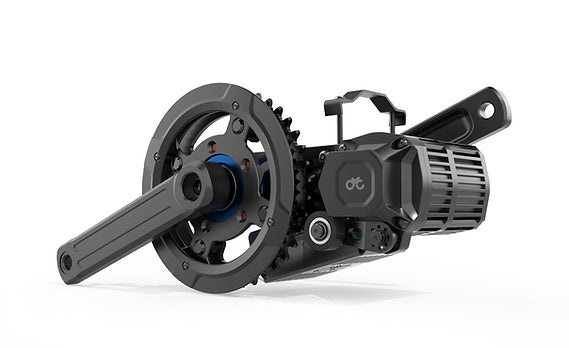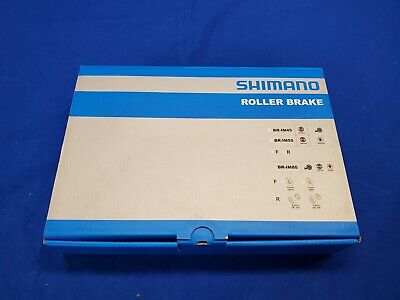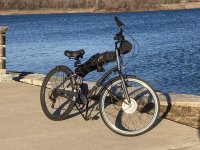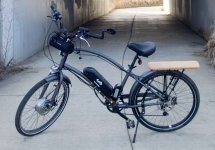I will do some more research. On crank vs hub drive. Maybe I jumped to the crank drive too early. This will be primarily for road/sidewalk use.
Crank drives are good for being able to shift the pedal drivetrain gears properly for varied terrain and riding conditions, to be able to use a lower power motor, smaller controller, and smaller battery to do a particular job more efficiently. They take more setup and more maintenance than hub drives.
If you don't have varied conditions or terrain, and always ride at essentially one slow speed on the sidewalks or roadside bike lanes, then a hub drive would be able to do the same job with the same small controller and small battery.
If you do have the varied conditions/terrain, and ride at a wide variety of speeds and need to accelerate quickly, a hubmotor will need to be more powerful, take a bigger controller and bigger battery to do the job vs a crank drive that you are shifting gears properly for.
You can experiment with various systems on the simulators at ebikes.ca with your specific conditions/etc to see how this works.
Bargain basement disc brake bikes often come with cable operated disc brakes which I have found to be useless for actually stopping the bike.
Cable operated brakes can work just fine, as long as they are good ones (like the single Avid BB7 I use with a 200mm rotor on the front of the heavy heavy-cargo trike SB Cruiser, which is enough stopping power to easily skid the wheel (you can't get more braking power than whatever it takes to skid the wheel).
Crappy ones like those that come on cheap bikes don't work very well, but that would be true even if they were hydraulic--it's not the activation method, it's the caliper design and manufacturing process.

Also, some cables are better than others--crappy cables can stretch more and sheaths have more friction and can also bind so not fully release the caliper, and crappy levers can flex more so not pull as hard. But poorly-bled or otherwise-problematic hydraulics can be mushy and respond much like crappy cables.
(but if a cable breaks roadside you can sometimes do a fix that will get you home; a hose breaking is probably not a roadside fix)
Another problem is often enough with crappy forks (especially cheap suspension ones) the lowers can twist during braking and misalign the pads to the rotors (both for rim and disc) and reduce braking or even cause it to not work at all.
Maybe I have an incorrect view of disc brakes. I thought that they would provide better stopping power, especially in damp/wet conditions. Is my brake selection a poor choice. I wasn’t looking for the cheapest. My goal is safety first.
It's not really disc vs rim, but good design/manufacture vs bad, not just of the calipers, levers, and activating interconnect, but of the frame/fork.

What problems do you have in your normal rides?
I've used both with just as much success on my heavy cargo bikes and trike, as long as they're good enough brake quality--once the brake is strong enough to stop the wheel from spinning and skid the tire, that's as good as it gets.
Here in Phoenix, it's dry almost all the time, but when it gets wet it's usually either just enough to make the road slick with oil and flinty slimy dust-mud on the thin spattering of sprinkles so tires skid so easily that brakes of any kind are nearly useless, or it's inches deep and flowing down the streets as rivers, and washes the oil off rapidly, so braking is degraded but still possible.
Wet conditions can degrade both disc and rim brake performance, the rims will get wet first if it's just puddles, but if it's actually raining they'll both be wet and degrade performance--by how much depends on the rotor / rim surface, and the pads in use. Discs will get hot faster so they may boil away the water faster, but (especially hydraulics) because they get hot faster (smaller surface area, smaller thermal mass) they can also degrade performance if the caliper design or pad type performs less well as temperature increases.
Road contaminants (oil, etc) during the first part of the rain can splash on both rim and disc, but usually get on rims first. If you don't have this problem where you ride, then either type works just as well. If you do, then the disc will take longer / more splashing for the problem to happen, but with less rotor surface area to smear it on it can sometimes be a worse problem...but either way if the oil gets into the pads they can just plain stop working and you may have to replace them to fix it (you might be able to sand them down, though I've found this works better with the rubber rim pads than the metallic disc pads).
Pads make a huge difference too--there are many types and brands, and some work much better than others. Koolstop salmon work very well on rim brakes even when wet, though they can make quite a squealy racket under some conditions dependign on how well they're adjusted, and the particular rim surface. Semi-metallic pads on my Avid BB7 discs are normally quiet and grippy. I've used cheap garbage pads and they "work' but are not as good as the OEM ones and wear out really fast; my next experiment will be to try Koolstop pads for the BB7 when I run out of the others I've already got (which won't take long).

 www.electrifybike.com
www.electrifybike.com

 www.electrifybike.com
www.electrifybike.com




